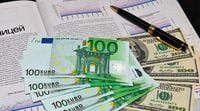As of April 16, 2025, the Central Bank of the Russian Federation reported official exchange rates for foreign currencies, marking notable fluctuations in the currency market. The dollar is now valued at 82.3003 rubles, while the euro stands at 93.6844 rubles. This represents a decrease of 47 kopecks for the dollar, equivalent to -0.57%, and a slight strengthening of the ruble against the euro, which decreased by 48 kopecks, or -0.51%.
Since the beginning of April, the dollar has weakened significantly, losing 3 rubles and 20 kopecks in value. The euro, however, has seen an increase of 1 ruble and 26 kopecks during the same period. The cross-rate for EUR/USD is currently set at 1.1383, indicating that one dollar costs approximately 0.8785 euros.
On the Belarusian Currency and Stock Exchange (BCE), trading results from April 15, 2025, reflected similar trends. The dollar's exchange rate was recorded at 3.0827 BYN, having slightly decreased throughout the day. In the morning, the dollar started at 3.085 and saw a minimum rate of 3.0797, with a maximum of 3.0859 rubles. The trading concluded with a decrease of 0.0028 BYN for the dollar, marking a -0.09% change for the day.
Over the past week, the dollar has weakened by 0.0624 rubles (1.98%), and in the past month, it has lost 0.0649 rubles, or 2.06%. Meanwhile, the euro's average exchange rate against the ruble increased slightly by 0.0086%, finishing at 3.51 BYN on April 15. In the last week, the euro gained 0.0256 rubles (0.75%), and over a month, it strengthened by 0.0472 rubles, or 1.39%.
Interestingly, the Russian ruble saw a slight appreciation against the Belarusian ruble, gaining 0.0046 rubles (0.13%). The ruble was fixed at 3.66 for 100 RUB on April 15, showing a strengthening of 0.0082 rubles (0.22%) over the past week and 0.0466 rubles (1.29%) over the month. In contrast, the Chinese yuan weakened against the ruble, dropping by 0.0065 rubles (0.15%) to 4.19 for 10 CNY. The yuan's decline over the past week was 0.0328 rubles (0.78%), and for the month, it fell by 0.125 rubles (2.9%).
In a broader context, on April 11, it was reported that the official exchange rate for the yuan had dropped from 11.53 rubles to 11.44 rubles. The dollar's value also saw a significant decline, initially falling from 85.01 rubles to 84, before stabilizing at 82. This marked the first time since March 19, 2025, that the dollar had dropped to such a low level on the Russian interbank market.
On April 15, at 12:50 PM Samara time, the dollar fell further by 2.78%, reaching a low of 80.91 rubles. Meanwhile, the euro's value increased by 0.24%, resulting in a new exchange rate of 94.62 rubles.
These fluctuations in currency values reflect ongoing economic conditions and market sentiments, with various factors influencing the strength of the ruble against other currencies. As the Russian economy continues to navigate these challenges, traders and investors remain attentive to currency trends, which can have significant implications for international trade and economic stability.
For those looking to exchange currencies, it's important to stay informed about these rates, as they can affect purchasing power and investment decisions. The current trends suggest a dynamic and potentially volatile market, where even slight changes can have broader economic consequences.
As the situation develops, analysts will be watching closely to see how these currency fluctuations impact the overall economic landscape in Russia and beyond. With the ongoing shifts in global markets, the importance of understanding currency dynamics has never been more critical.






